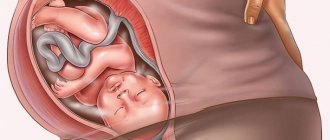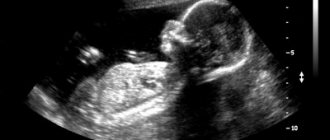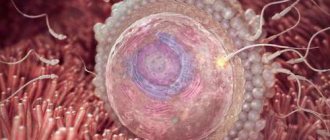Table “Cervical length during pregnancy by week”
The organ matures rapidly during the last two prenatal weeks. Its length is reduced to one centimeter, and the cervical canal, closed by a mucous plug throughout the entire gestation period to protect the fetus from various infections, opens and forms an exit from the uterus to the vagina. This is how the body should prepare for the birth process; all deviations have their own reasons and require mandatory correction.
As can be seen from the table, the average length of the cervix at 25 weeks of pregnancy is 41 mm.
The normal course of pregnancy depends on the condition of both the uterus itself and its lower segment - the cervix. By holding the baby in the uterine cavity and ensuring its connection with the vagina, it directly affects the development of labor. It is important to promptly monitor its length in order to prevent problems that may arise due to various violations.
Pregnancy by month. Seventh month of pregnancy (25-28 weeks)
Week 25 The 25th week of pregnancy corresponds to the 23rd week of fetal development and begins the seventh month of pregnancy. Just a little more and the second trimester will be left behind, and you will move into the most responsible, but also difficult period of time - the third trimester, which will significantly bring your meeting with the baby closer. The onset of the 25th week of pregnancy, the sensations during which are associated with the rapidly increasing size of the tummy, is a kind of boundary that somewhat reassures mothers whose pregnancy is proceeding with the threat of termination. Now, with each passing week, premature births will give more and more chances for a successful outcome; even at this stage, newborn children often survive.
Of course, childbirth at 25 weeks of pregnancy is not normal and poses a huge threat to the life and health of the child, but now the chances of his survival are rapidly increasing.
You quickly gain weight, gaining 250-300 grams every week; at the 25th week of pregnancy, a woman’s weight has already increased by 6-7 kg, and you have to gain another 3-5 kg before giving birth. In many ways, the weight gained depends on how much the baby will weigh, how much you weighed before conception; usually obese women gain less weight than thin women who were poorly nourished before pregnancy. A useful tip during the 25th week of pregnancy is to do Kegel exercises to strengthen your pelvic floor muscles. These muscles form the sphincters of the urethra, anus and vaginal opening. Labor and urinary control depend on their condition. The pressure of the growing uterus causes these muscles to stretch and weaken. You can read about this in detail
Sex at 25 weeks pregnant
Having sex at 25 weeks pregnant will likely force you to give up many of your previously favorite positions, such as cowgirl.
Changes in a woman’s body at 25 weeks:
Week 25 is the beginning of the end of the second trimester, that is, all the most significant changes in the mother’s body have already occurred, but small changes still take place here:
- The uterus grows to the size of a football;
- The fundus of the uterus rises to a distance of 25-27 cm above the womb;
At week 25, your doctor may take blood to check for anemia.
With an active increase in blood volume in the body, the number of red blood cells per unit of volume becomes smaller - a phenomenon called physiological anemia and characteristic of the second and third trimesters. If anemia is detected (the content of hemoglobin - the main component of red blood cells - in the blood decreases, in which case a blood test will show the hemoglobin content in the blood is less than 12 g/l), the doctor will prescribe the medications necessary to maintain health. And your baby also haunts you. He is already quite large; at 25 weeks of pregnancy, movements are very distinct, and sometimes even painful. Sometimes you can even guess a part of the child's body, a heel or an elbow.
your child
A child at the 25th week of pregnancy begins to experience increasingly greater restrictions, and the space in the uterus becomes less and less. Most babies are already lying in the uterus as needed for childbirth, with their head facing the exit, but if they are still with their buttocks down, there is still time to turn over. Due to the fact that there is less space, you feel his movements more and more clearly. At week 25, your uterus has already risen at least 25 cm from the womb, and it becomes more difficult for you to bend over.
The size of the fetus at week 25 is about 30 cm in length (the newborn is about 50 cm tall) and weighs 700 grams. The development of the fetus now means growth and weight gain, even to a greater extent it is now becoming heavier as it grows in length.
The baby's brain weighs more than 100 grams, periods of sleep are replaced by episodes of wakefulness, which you feel as the baby's activity. At 25 weeks of pregnancy, the movements of the fetus do not seem to depend at all on your mood and desires, whether you are sleeping or not, it lives according to its own schedule. But you may notice that it quiets down if you are walking, if you are in a boat and a wave is rocking you, if you are driving a car on a good road. The baby is simply rocked, and the same will happen after he is born.
A fetus at 25 weeks of gestation quite often... hiccups. Hiccups do not indicate any pathology, but it is still worth telling your gynecologist about it. It usually occurs due to the fact that the baby swallows amniotic fluid, what happens when this happens? The stomach fills with amniotic fluid, and this causes irritation of the diaphragm, the large muscle that separates the abdominal cavity from the chest cavity. It is its contractions that manifest themselves as hiccups.
At 25 weeks of pregnancy, the baby's development already allows it to survive outside the womb. The lungs have completed their formation, and now there is active formation of surfactant, a substance responsible for the expansion of the lungs after childbirth and the first breath. Of course, the development of the fetus at 25 weeks of pregnancy is not complete, and it is much better in the womb than in any incubator, but still, now the child has a chance to live.
At 25-26 weeks of your pregnancy, the baby is able to respond to visual and auditory stimuli: bright light and sharp sound. If a pregnant woman’s belly is illuminated with a bright lamp, then in response to this the fetus exhibits a motor reaction - it makes movements with its eyelids, arms, legs and head. In response to sharp sounds, the fetus shrinks fearfully or, on the contrary, begins to behave very restlessly.
Education and functioning of organs and systems:
- Intensive strengthening of the osteoarticular system continues;
- Heartbeat can be heard. The fetal heart beats at a rate of 140-150 beats per minute;
- A boy's testicles begin to descend into the scrotum, and a girl's vagina begins to develop;
- The fingers acquire dexterity and are able to clench into fists. He already gives preference to one hand (you can determine who the baby will be: left-handed or right-handed);
- By this week, the baby has developed his own special sleep and wakefulness pattern;
- The development of the bone marrow ends, it fully takes over the functions of hematopoiesis, which until now were performed by the liver and spleen;
- The formation of bone tissue and active deposition of calcium in it continues;
- Surfactant continues to accumulate in the lungs, preventing the lungs from collapsing after the newborn’s first breath;
An ultrasound at the 25th week of pregnancy is not done often, the second screening is over, and the last planned ultrasound is not yet soon. However, sometimes an examination is still prescribed as necessary. Your baby is already so big that he cannot fully fit on the ultrasound machine screen, but body parts are easily distinguishable. Ultrasound allows you to determine the weight of the fetus, its size and position in the uterus, assess the condition and place of attachment of the placenta, and the amount of amniotic fluid. An ultrasound scan of the fetus at 25 weeks of pregnancy evaluates the baby's spine. You can already find out for sure who lives inside - a boy or a girl. An error is possible in extremely rare cases, due to the inconvenient position of the fetus for examination. During an ultrasound scan of the fetus at the 25th week of pregnancy, you are told that the baby’s weight is approximately 630 g and height is 32 cm. If an ultrasound scan of the fetus reveals polyhydramnios or oligohydramnios during the 25th week of pregnancy, a thorough comprehensive assessment of the fetus over time is required to exclude defects development, signs of intrauterine infection, etc. Also, during the ultrasound at week 25, all necessary measurements are taken.
26 weeks.
26 weeks of pregnancy is the 24th week from the moment of conception and the end of the sixth month according to the standard calendar. The birth is just around the corner, two-thirds of the way has been completed. What happens in the mother's body at 26 weeks of pregnancy?
- Due to the raising of the abdomen above the navel by 6 cm, shortness of breath and a regular desire to take a deep breath appear;
- By this time, the expectant mother gains about 9 kg of weight;
- Nausea and heartburn occur due to an enlarged uterus.
- Pain in the lower back and nagging pain in the abdomen - the uterus becomes toned, which is due to painless training contractions;
- From the second half of the term, the uterus rises by 1 cm every week;
- The total weight gain (with a rational diet) ranges from 7.2 to 10 kg;
- Blood pressure rises, returning to pre-pregnancy levels;
- Swelling of the feet and legs may be accompanied by swelling of the face and fingers, which is associated with accumulated fluid in the body that is not removed in time;
- Existing age spots (moles, freckles) become brighter and more noticeable;
- Flatulence and heartburn increase;
- 26 weeks of pregnancy may also be accompanied by the appearance of nodes in the anus and legs (varicose veins);
- The uterus, enlarging and stretching, puts pressure on the internal organs, thereby complicating their activity:
The diaphragm is supported by the uterus, which prevents full breathing; The load on the heart increases; Constipation, bloating and other digestive problems appear; Due to stretching of the uterine ligaments, pain in the pelvic area and back increases.
- Vision problems are also common during this period.
Causes of vision problems at 26 weeks of pregnancy:
A large amount of fluid in the body of the expectant mother (as a result - swelling of the eyelids); An increase in blood volumes (as a result - a load on the vessels, the eye in particular, and microhemorrhages); Dry eye syndrome is a feeling of a foreign body in the eye, dryness, and redness.
- Numbness and tingling may occur - possible symptoms of poor circulation;
Sometimes a pregnant woman is bothered by a feeling of numbness in the arms and legs, cramps in the calf muscles, swelling in the legs and arms, especially after sleep.
The expectant mother needs to engage in simple sports exercises that help the vessels cope with the movement of blood from the extremities to the arteries and back - raising and lowering the arms, legs in a lying or sitting position, “scissors” with the arms and legs, lifting them up. You should choose the correct position while sleeping so that there is no compression of the limbs. A woman should always have several small pillows near her that can be placed under her stomach, shoulders, neck, or between her legs. At 26 weeks of pregnancy, the expectant mother often feels unpleasant spasms in the calf muscles, especially during sleep or after it. Cramps are most often caused by low levels of potassium and calcium in the body, but very high levels of phosphate. A woman needs to reconsider her diet and replace meat dishes with fish, seafood, and legumes in order to get complete protein. Calcium supplier – dairy products, cottage cheese, cheese. Every day, the expectant mother should eat 100 grams of cheese or 250 grams of cottage cheese, drink up to 1 liter of kefir.
Fetal development at 26 weeks of pregnancy
Weight and dimensions of the baby at 26 weeks of pregnancy:
Weight – about 800-1000 g; Length – about 32.5-34 cm; Head diameter – about 65.1 mm; The diameter of the chest is about 65.8 mm; The diameter of the abdomen is 67.4 mm.
- The child becomes active, and his movements are painful for the mother;
- Mostly lies head down, although its position may change many times;
- The baby's weight is primarily gained through muscle development and fat deposition;
- The skin is still red and thin, the cheeks are getting better;
- The child is already able to see and lives in the world of sensations. Formed vision allows him to see only blurry colored spots;
- The taste of amniotic fluid, which the baby already feels, directly depends on the food his mother eats;
- The baby gets used to the mother's heartbeat. That is why, after his birth, the baby immediately calms down, you just have to press him to your chest;
- The baby remembers sounds - the voices of his mother and relatives, music. At week 26, the baby hears you. If you sing lullabies to your baby now, then after giving birth he will quickly fall asleep to them;
- The development of the baby's lungs continues - he is already preparing for his first breath, swallowing amniotic fluid. The lungs take the shape of a triangle and are positioned with the apex upward;
- In boys, the testicles descend into the scrotum
- The baby still has a “senile appearance” - his skin is wrinkled, but subcutaneous fat continues to develop, and his legs and arms continue to smooth out;
- The cartilage of the child’s nose and ears is still soft, the nails do not yet reach the fingertips
- Heart rhythm – from 120 to 160 beats per minute;
- The ears are slightly protruding, the eyes are able to close completely;
- The pituitary gland begins to synthesize its own growth hormone;
- Connections are established between the brain and the adrenal cortex - hormonal levels are formed;
- The formation of permanent teeth occurs, which remain deep in the soft jaw tissue until they are replaced by milk teeth at the age of 5-6 years;
- The bone apparatus is strengthened;
27 weeks You are at the 27th obstetric week, which is the 25th week from conception and the 23rd week from the delay. The second trimester of pregnancy is coming to an end, and you are fully prepared for childbirth. You have reached the finish line; in a few months you will meet your baby. Your relationship with your husband has become very close and warm, you are preparing to become parents and, perhaps, preparing a dowry for your baby. Now you need to visit your gynecologist every 2 weeks, be sure to ask about everything that worries you. How does mom feel?
- The fundus of a woman's uterus is located at a height of 27 cm above the womb. The uterus still tends to grow upward; the woman notes that it has expanded to the sides. A pregnant woman's belly looks more and more like a giant ball - round, neat in shape.
- The mammary glands of the expectant mother are completely ready for lactation. If the baby is destined to be born now, at the twenty-seventh week, then he will be fully provided with breast milk - the question is whether he will be able to eat it on his own. Each mammary gland of a pregnant woman reaches a mass of 780 grams by this period; the expectant mother is forced to buy very large underwear. It is better if it is special underwear for pregnant women, made of natural fabric, which does not compress the mammary glands, but supports them from below. Colostrum can be released from the nipples, and the amount is quite large, so the expectant mother needs to use special inserts in the bra.
- In late pregnancy, a woman's cholesterol levels rise, but this should not worry you. Cholesterol for the placenta is an important building material with which it produces various types of hormones, including progesterone, which is responsible for the development of the mammary glands, relieving tension in the uterus and other smooth muscles.
- The belly grows and the skin on it stretches, which can sometimes cause severe attacks of itching. In this case, preventive measures in the form of applying a soft cream, for example, almond milk, will help. But be careful, now you can’t use cosmetics based on oils for fragrance. They can cause allergies and also overstimulate the nervous system.
- During this period, you may feel hot, not only in the warm season, but also in the cold. Sweating also increases, and there is a need for frequent hygiene.
Video on the topic of 27 weeks of pregnancy - “Unpleasant companions of pregnancy”
- A positive thing at this time can be very clear and colorful dreams about your baby.
- In the third trimester, the weight of the expectant mother grows very quickly. All for the most part due to an increase in the amount of blood and amniotic fluid, as well as the growth of the uterus, placenta and the fetus itself. Your own fat accounts for a small share (if, however, you do not overuse flour, fatty and sweet foods), which will mainly go away during childbirth and during breastfeeding. So don’t let your own size scare or upset you: all this is temporary and necessary for the baby’s health.
Back pain is a traditional complaint of pregnant women. It increases with increasing pregnancy and disappears without a trace after childbirth. There are two main causes of discomfort - increased body weight and changes in the center of gravity caused by muscle imbalance and muscle fatigue due to increased loads.
- Watch your posture - to find the right position, stand with your feet shoulder-width apart and your arms at your sides. Make sure your body weight is evenly distributed between your legs. Straighten up and stretch your neck - imagine that you are being pulled by a spring attached to the top of your head.
- Avoid sleeping on your back - this reduces blood flow and can cause fainting.
- Sit in chairs that have good back support. Your knees should be higher than your hips.
- Sleep on your side on a firm mattress. Place a pillow between your legs and under your stomach to support your back.
- When rising from a sitting position, place your feet shoulder-width apart and bend at the waist, not at the knees.
- Don't lift heavy objects. If this is still necessary, distribute the weight evenly between 2 bags or put the backpack on both straps.
- Wear low-heeled shoes.
- Wear supportive underwear.
- Go swimming.
Don’t forget to communicate with your baby, preferably with dad.
Already now you are a family, the child gets used to his parents, feels them, recognizes them. Give each other only the best emotions - there is not much left for the long-awaited meeting... Fetal development at 27 weeks of pregnancy
All organs and systems are already established and the baby is actively training them. If he were born now, his chance of survival would be 85%. With prompt and proper care, the baby will not differ from his peers in the future. His height is 35 cm and his weight is about 1 kg.
- The baby becomes prettier: the folds on his body disappear, the subcutaneous fat layer becomes thicker.
- His eyes are slightly open, now his reaction to light is even sharper, he can even turn his head away if a bright light shines into his eyes.
- Your baby feels pain and may clench his fists and puff out his cheeks.
- Swallowing and sucking reflexes are now improving.
- This week, the baby is actively developing the area of the brain that is responsible for consciousness and thinking.
- Your baby can dream.
- The child is very active: he rolls over, stretches and kicks.
- During this and subsequent weeks, the child assumes the so-called flexion position.
- Now you can even see what your baby is pushing with: an arm or a leg.
- From this week, the baby has an 85% chance of surviving a premature birth. So from now on the child already has very real vitality.
28th week of pregnancy
The 28th obstetric week corresponds to the 26th week of fetal development and ends the second trimester of pregnancy. So, the 7th month of pregnancy is coming to an end, but there is still an equally important third trimester ahead. Even if your baby asks to come out at 28 weeks, doctors will be able to help him, and he will live. What happens in the mother's body at 28 weeks of pregnancy?
- More than half of the journey has been completed, with only 12 weeks left, but certain changes are still happening in your body:
- The uterus increases in size;
- The uterus occupies a position at a distance of 8 cm from the navel and 28 cm from the pubic symphysis;
- The mammary glands begin to produce colostrum;
- The uterus rises so high that it props up the diaphragm, making it difficult for a woman to breathe;
The 28th week of pregnancy is the time when you can start performing the Pearson test - counting movements for an hour in the morning and evening.
A healthy fetus at this stage makes at least 10 noticeable movements per hour. In general, during the day, a child should normally make at least 20 tangible movements. You should be wary if you feel much less tremors or if they disappear altogether. A pregnant woman does not yet experience severe heaviness at this stage, but heaviness in her legs is already beginning to appear, and spider veins may appear on her hips and legs. The fact is that the 28th week of pregnancy is the beginning of the rapid growth of the uterus, which now compresses the blood vessels, causing venous stagnation in the lower half of the body. If you had varicose veins before pregnancy or your immediate family suffers from this disease, take care of your legs now. In orthopedic stores you can find special tights or stockings that will moderately compress the shins, supporting the walls of the blood vessels.
If you have a multiple pregnancy, you are already entitled to maternity leave at the 28th week of pregnancy. Now your main task is to properly prepare for childbirth. It is very important to be not only physically prepared for the process of giving birth to your babies, but also to study the theoretical basis of this issue. Start studying special literature that will help you overcome fear, prepare psychologically, and learn relaxation techniques.
The twenty-eighth week of pregnancy is great for collecting a dowry. Even if you decide to make vests and caps with your own hands, you will most likely have enough time for this. However, as a rule, Russian women prefer another method - is it possible to resist the window of a children's store and not choose the best clothes for your long-awaited baby? While it’s not too difficult for you to move around, take advantage of this opportunity - you probably won’t stop at just one store. Think about how your birth will go, start choosing a maternity hospital, discuss with your husband the possibility of a partner birth. Video
Fetal development at 28 weeks of pregnancy
Appearance of the fruit:
- The child recovers sharply and his weight reaches 1-1.3 kg;
- The baby's height becomes 35-37 cm;
- The baby's eyelashes lengthen and become more voluminous;
- The skin becomes smoother and softer (the reason is an increase in the volume of subcutaneous tissue);
- Fingernails and toenails continue to grow;
- The hairs on the baby's head become longer;
- The baby’s hair acquires an individual color (pigment begins to be actively produced);
- The face and body are covered with protective lubricant.
Education and functioning of organs and systems:
- The alveoli in the lungs continue to develop;
- Brain mass increases;
- Typical convolutions and grooves appear on the surface of the cerebral cortex;
- The ability to distinguish subtle varieties of taste appears;
- The ability to respond to sounds is developed (the baby can respond to the voice of the mother and father with slight movements);
- Such reflexes are formed as sucking (the baby in the mother’s tummy sucks his thumb) and grasping;
- Muscles are formed;
- The child's movements become more active;
- Certain biological clocks are established (period of activity and period of sleep);
- The baby's bones are finishing their formation (however, they are still flexible and will harden until the first weeks after birth);
- The baby has already learned to open and close his eyes, as well as blink (the reason is the disappearance of the pupillary membrane);
- The rudiments of understanding the native language (the language spoken by the parents) are formed.
Ultrasound at the 28th week
With an ultrasound at the 28th week, the size of the baby from the coccyx to the crown is 20-25 cm, by this time the legs are significantly lengthened and amount to 10 cm, that is, the total height of the baby reaches 30-35 cm.
An ultrasound at 28 weeks is usually prescribed to determine the position of the fetus: cephalic, transverse or pelvic. Typically, babies are in the head position at 28 weeks (however, if your baby is not positioned properly, he has another 12 weeks ahead). In case of a pelvic or transverse position, a woman is most often offered a cesarean section.
At an ultrasound at 28 weeks, you can watch how the baby moves in the tummy and how it opens and closes its eyes. You can also determine who the baby will be: left-handed or right-handed (depending on the thumb of which hand he sucks). The doctor must also take all the basic measurements to assess the correct development of the baby. For clarity, we provide you with the norm for the size of the fetus: BDP (biparietal size or distance between the temporal bones) - 6-79mm. FZ (fronto-occipital size) - 83-99mm. OG (fetal head circumference) - 245-285 mm. Coolant (fetal abdominal circumference) - 21 -285 mm.u
From the book by W. and M. Sears “All the necessary information for the expectant mother from the birth of the idea to the birth of the child”
Developing your own philosophy of childbirth
Your attitude towards childbirth is inextricably linked with your attitude towards life. Developing a birth philosophy and changing your views during the process can have a beneficial effect not only on your birth, but on your life in general. Perhaps you have not yet developed your own philosophy of childbirth or do not even understand what it is and why it is needed. Like a philosophy of life, a philosophy of childbirth involves answering the question of how you imagine childbirth to be. What is important to you? What are your priorities? How much effort are you willing to give to achieve your desires? What do you need to do to get what you want? Who should you consult? It is not only the final result of childbirth that is important, but also the process itself.
Having a birth philosophy means being involved in the birth of your baby and the decisions it requires. This means that you must recognize the value of the process of pregnancy and birth, not just the end result. Childbirth is the quintessence of your feminine essence, and the memories of it last a lifetime. You want not only to have a baby, but also to gain satisfaction from this process (for different women this can be different things).
Pregnancy and childbirth are physiological, not pathological processes. These are natural life processes through which millions of women have gone through, and many have agreed to do this more than once. Developing your own philosophy of childbirth partially removes the fear of childbirth. The more you learn about childbirth, the more you realize that much more depends on you than you previously thought.
If at this point you have not yet developed your own philosophy of childbirth, then perhaps the following recommendations will help you with this.
Expand your capabilities. As labor approaches, not only does your baby grow and your body expand; The brain is receiving more and more information and learning to make sense of that information and use it to give you the birth you want.
Trust your body. Millions of women have proven through their own experience that the female body is designed for childbirth. If you understand how your body works during labor and how you can help rather than hinder it, you are much more likely to have a safe and satisfying birth.
Maintain optimism. Surround yourself with optimistic advisors. Depending on what literature you read and whose opinions you listen to, it is easy to get confused by all the possible options and start talking about troubles that can happen during childbirth, forgetting that in most cases childbirth occurs without complications. The more convinced you are that everything will go well, the more likely it will be.
The development of a philosophy of childbirth gives impetus to the formulation of a philosophy of motherhood. Many of the challenges you will face to ensure a smooth pregnancy and a satisfying birth are similar to those you will face after becoming a mother. You will learn to trust yourself and not pay attention to various advice. In addition, you will discover that your body is wonderfully designed not only for giving life, but also for motherhood.
Childbirth is a precious time that you will, we hope, remember with reverence for the rest of your life. You have the power to influence the nature of your memories.
Why is medical supervision needed?
It is advisable to conduct an examination of the cervical canal before conception. If it is shortened or there is another pathology, this will allow maintenance therapy to be started in advance and will minimize the likelihood of miscarriage.
Medical supervision is mandatory throughout pregnancy so that a specialist can monitor the condition of the cervix and fundus of the uterus and, if necessary, can quickly respond and select effective therapy.
Normal indicators
Until week 20, the size remains virtually unchanged, and there is no need for observation, however, further changes should be monitored. Although the length of the cervical canal is slightly different for all women, there are certain standards that allow you to control the process and make it possible to detect deviations. Standard indicators are determined based on medical research. To continue the pregnancy, if something goes wrong, urgent treatment or hospitalization may be required.
At the beginning of the article there is a table indicating the normal length of the cervix at 25 weeks.
Analyzes and research
Somewhere from the 25th week, the frequency of consultations with a gynecologist increases to 2 times a month.
The doctor monitors changes in the circumference of the abdomen and pelvis, weight, and always listens to the fetal heartbeat. A pregnant woman is prescribed tests:
- General blood analysis. Allows you to detect anemia. If necessary, iron supplements are prescribed.
- Blood sugar testing to determine glucose levels. Even in healthy women, the production of the hormone insulin can be disrupted during pregnancy.
- Analysis of urine. The presence of protein indicates improper kidney function.
- A vaginal smear is taken if there are complaints of pain or suspicious discharge.
A planned ultrasound of the fetus is done a little earlier, at approximately 20-22 weeks. At the 25th week, an ultrasound is performed according to the doctor’s recommendations.
Diagnostic methods
The condition of the uterus and all its elements is assessed using two methods:
- When examined in a chair by a gynecologist. The doctor determines the approximate density and length of the cervix, its location in relation to the pelvic axis, and the condition of the external pharynx.
- Through ultrasound. The examination allows you to determine the structure of the external and internal pharynx and calculate the length of the lower segment.
At mid-term, the fetus begins to grow faster, which puts more strain on the muscles, so regular examinations become especially important. Also at this stage, a second screening ultrasound is performed, in which special attention is paid to the cervical canal. If there is a suspicion that it is shortened, a transvaginal examination is auxiliary, which involves inserting a sensor into the vagina, making it possible to measure the length more accurately.
Causes of soft cervix during pregnancy
In addition to indicating the onset of labor, a soft cervix develops at different stages of pregnancy for the following reasons:
- pathological decrease in muscle tone in the organ (due to softening of the walls, the muscles of the organ cannot fully hold the fetus inside), which leads to an increase in pressure inside the uterus and the occurrence of premature birth. This condition is typical from 20 to 30 weeks;
- inflammatory processes in the cervical canal or vagina;
- gynecological diseases associated with a violation of the ratio of connective and muscle tissue (endometriosis, ectopia, etc.);
- hormonal imbalance in the body;
- previous births with severe trauma (a large number of ruptures, scar formation, etc.);
- taking medications that affect the condition of the uterus (prostaglandins, etc.);
- a large number of scrapings, which were accompanied by constant mechanical damage.
Also, the cervix shortens and becomes soft before menstruation. This happens to make it easier for sperm to enter the cavity and fertilize the mature egg.
If fertilization does not occur, then the woman experiences abundant mucous discharge from the cervical canal. Next, the uterus begins to gradually descend, returning to its original place, the cervix expands, and so-called uterine bleeding appears, which contains unfertilized eggs. This causes the cervix to become very soft.
But if pregnancy does occur, then the cervix acquires a solid structure and, as it were, closes the entire organ. This is created so that the fetus can develop calmly and not leave the organ area. The softening of its walls should occur immediately before childbirth. Shortening of the walls and changes in their density in the early stages indicates a serious pathology.
Intimate life at 25 weeks of pregnancy
During this period, the closeness of parents does not in any way affect the health of the baby. Moreover, his mother’s good mood will have a positive effect on him. However, future parents should follow several rules if they do not want to interrupt sexual relations during pregnancy:
- All positions should be comfortable for the pregnant woman.
- It is necessary to avoid excess pressure on the abdomen, which can cause increased uterine tone.
- If there is a threat of miscarriage and the doctor recommended abstaining from intimacy, then it is not worth risking the baby’s life.
- If after sexual intercourse a woman notices the appearance of bloody discharge or tension in the muscles of the uterus, accompanied by painful cramping sensations, it is necessary to call an ambulance.
Soft cervix as a harbinger of labor
Starting from the 37th week of pregnancy, a woman begins to prepare for the onset of labor. This is a very exciting moment; it requires increased attention, both from the expectant mother and from doctors.
Important! Normally, the cervix is located quite high from the vagina; as the child grows, it approaches it. If, upon examination at 37-39 weeks of pregnancy, the cervix has a very soft structure and opens wide, then the woman is immediately sent to the delivery room.
Among the harbingers of labor include the release of the mucus plug, which covers the lower part of the cervix and the entrance to the vagina. This is followed by the release of amniotic fluid and the onset of labor pains. In this case, the cervix should be located very low, almost in the very center of the vagina.
Ultrasound at 25 weeks of pregnancy
It should be noted that at 25 weeks of pregnancy this examination is not required. The second examination was carried out from 18 to 21 weeks (or from 20 to 24 weeks), and the third ultrasound is still far away. Despite the fact that ultrasound is relatively safe for the baby’s health, it is not recommended to perform it too often. But there are indications for additional examination. If a woman has bleeding or the activity of the fetus has changed, the gynecologist may prescribe an ultrasound to assess the condition of the expectant mother and her baby.
Shortened cervix during pregnancy at 25 weeks
This deviation is dangerous, as it not only threatens the normal course of pregnancy, but can also provoke a miscarriage.
Causes and consequences
Factors that can cause excessive shortening in the early stages include:
- anatomical and physiological characteristics of the body as such and the reproductive system in particular;
- scars left after an abortion or other surgical interventions, or as a result of muscle rupture during a previous birth;
- pelvic diseases of an inflammatory nature;
- infections suffered during pregnancy;
- complications caused by bleeding;
- progesterone deficiency and other hormonal disorders;
- psychogenic factors such as stress and fear.
IMPORTANT! Most often, shortening of the organ indicates isthmic-cervical insufficiency. Its danger lies in the fact that the cervix with this pathology cannot hold the child in the uterine cavity: it opens prematurely, unable to withstand the load, which entails premature birth.
Alcohol at 25 weeks
Alcohol, even if you drink in small quantities, is harmful to the still imperfect kidney and liver system of the baby in the womb. Just imagine how much ethanol will be removed from the child’s body. Therefore, do not pay attention to harmful advice that, for example, wine helps increase hemoglobin.
Alcohol has a detrimental effect on the baby’s brain and, in addition, causes addiction. Therefore, after drinking a small amount of alcohol, it is no longer the pregnant woman herself who wants sparkling wine, but her unborn child.
Symptoms of ICN
The diagnosis of isthmic-cervical insufficiency is determined on the basis of medical studies, however, there are signs by which a pregnant woman can identify a possible problem before undergoing an ultrasound. The pathology is often accompanied by bursting pain in the vagina, which also spreads to the lumbar region and groin.
However, you cannot rely only on the absence or presence of pain. The course of ICI can be asymptomatic, and the woman will not feel anything suspicious until the very moment when it is no longer possible to save the situation. This is why observation by a gynecologist is necessary.
Treatment
What therapeutic measures need to be taken in each specific case is decided by the doctor, based on the cause of the pathology. So, the following can be used:
- Hormonal drugs. They are prescribed in cases where INC is caused by endocrine disorders and restoration of hormonal levels can still return the size of the organ to normal.
- Installation of a pessary. It is a ring made of silicone or plastic and is installed directly in front of the canal through the vagina. The procedure takes only a few minutes and does not require painkillers. The pessary supports and is used in combination with medications. A pregnant woman with an obstetric pessary should remain in bed most of the time and avoid any stress to ensure that the device does not become dislodged and performs its function properly.
- Cervical cerclage. This procedure is also known under a simpler name, which immediately reveals its essence - suturing the cervix. There are two main methods by which cerclage can be performed: Shirodkar and MacDonald. The latter involves the application of temporary circular sutures, which temporarily narrow the canal and are removed at approximately 37 weeks of pregnancy. If cerclage is carried out according to the first method, then the suture will be permanent, and childbirth will require a cesarean section. Being a surgical intervention, cerclage is performed under anesthesia - epidural or spinal, less often general.
Regardless of what kind of treatment was prescribed, constant medical supervision is a prerequisite for therapy. The specialist must keep the process under control in order to correct it in time if necessary.
Medical supervision is especially important in the first time after cerclage has been performed, since the procedure is associated with certain risks. To make sure that the surgical intervention does not provoke premature onset of labor, doctors monitor the pregnant woman’s condition for several hours. During the first week, it is advisable to move as little as possible and observe bed rest, and you also need to mentally prepare for the fact that after suturing, cramps and minor bleeding are possible for several days.
Elongated cervix
Not only a short, but also a long neck is possible. This situation may be due to the following reasons:
- atypical structure of the patient’s organ;
- previous operations;
- an unformed or disturbed generic dominant, which manifests itself in a depressed state of mind, fear of the upcoming birth.
The elongated canal does not affect the course of pregnancy at all and does not pose a danger to the development of the fetus, but it can complicate the birth itself. The long neck usually has a compacted structure - obstetricians sometimes call it “oak” - and does not open well during contractions, and in some cases does not open at all, which will require an emergency caesarean section.
In order for the birth to take place naturally and without complications with an elongated organ, the woman is prescribed medications that are designed to soften and smooth out the structure. As a rule, such therapy is carried out in preparation for childbirth.
Vitamins at 25 weeks of pregnancy
Gynecologists do not always prescribe vitamin complexes to pregnant women, since there must be certain indications for this. However, despite the variety of products in stores, not all the necessary nutrients enter the body of the expectant mother. Therefore, after discussing with your doctor the need for fortification of the body, you can drink a vitamin complex. But you shouldn’t prescribe it yourself.
During this period, the woman’s body (since the baby receives all the necessary substances from her) especially needs a sufficient supply of iron and calcium. When shaping her diet, a woman should pay special attention to products that contain these elements. In some cases, the doctor prescribes iron or calcium supplements, depending on the body’s needs.
Prenatal changes
The lower segment of the uterus is a hollow ring-shaped muscle, the length of which in non-pregnant women is mainly from 4.5 to 3 cm. During pregnancy, it gradually contracts, this process begins to take place actively from the 37th week (the rates of changes at earlier stages are shown in the table above).
The organ becomes not only shorter, but also softer and centered in relation to the pelvis. The period during which these changes occur varies depending on the characteristics of the reproductive system of the woman in labor. So, in some women, the cervix smoothes out to the final state (1-1.5 cm) and opens properly over several days or even weeks, while in others this process takes place within a day or just a couple of hours before the onset of contractions.
Whether a woman gives birth for the first time or the second time does not have much influence on the course of changes. The process sometimes differs only in that in pregnant women who have given birth before, the contraction during the early stages will be less pronounced, but will pass quickly immediately before childbirth.
From the moment of conception to childbirth, the cervix undergoes various changes, the most important of which is shortening in length. This indicator affects whether the expectant mother will be able to carry the child for the entire prescribed period or not, and deviations from the norm are fraught with such serious consequences as miscarriage and premature onset of labor.
A short cervical canal, however, is not a categorical contraindication to motherhood, and the negative impact of the pathology can be balanced by various therapeutic measures, in particular the use of a pessary or cerclage. In order to identify the problem in time and eliminate it, you need to be observed by a gynecologist and take his recommendations responsibly.
Baby at 25 weeks of pregnancy
The fetus at 25 weeks of gestation is growing rapidly. Subcutaneous fat, which is represented mainly by brown adipose tissue, gradually increases in volume, the skin turns from wrinkled to smooth, and folds appear in appropriate places (in the buttocks, for example).
The development of the fetus at the 25th week of pregnancy is characterized by the fact that almost all systems are already formed, with the exception of the respiratory system, in which the gradual formation of surfactant occurs. This substance prevents the alveoli, the bubbles in which gas exchange occurs, from sticking together. If previously the hematopoietic function was performed by the liver and spleen, now the bone marrow is responsible for the formation of blood cells. At the same time, active formation of bone tissue occurs due to the growth of the baby. In addition, a child at 25 weeks of pregnancy can already sense taste, because the taste buds in his mouth are fully formed.
What does a baby look like at 25 weeks of pregnancy? It looks the same as a newborn, except that it differs in body size. The skin turns pink, the body becomes rounded due to adipose tissue. The eyes, nose and mouth are where they should be, and the eyebrows and eyelashes are already fully formed. The baby's ears have also taken their place, but so far the cartilage of the auricles is quite soft. The closer to childbirth, the harder they will become.
The weight of the fetus at the 25th week of pregnancy is 650-700 g, and the height is 31-32 cm. The development of the child at the 25th week of pregnancy occurs quite rapidly, the baby is actively gaining muscle mass, which is expressed in stronger tremors.
Week 25Your baby is the size of a spaghetti squash











